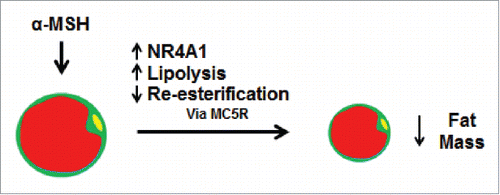Figures & data
Table 1. Transcription factors involved in adipocyte differentiation.
Figure 1. Adipogenic effects of NPY during adipocyte differentiation. When neuropeptide Y (NPY) is included in the differentiation cocktail of preadipocytes and cells from the stromal vascular fraction (mesenchymal stem cells (MSC) and preadipocytes (PreAd)) there is increased cellular proliferation of the precursor cells, a process thought to be mediated primarily via NPY receptor 2 (NPY2R). Throughout differentiation, there is increased expression of peroxisome proliferator activated receptor (PPARγ) and CCAAT/enhancer-binding protein α (C/EBPα), and decreased expression of uncoupling protein 1 (UCP1), thereby leading to increased lipid accumulation in the terminally differentiated adipocyte. Yellow represents the cell nucleus and red represents the lipid droplet.

Table 2. Physiological actions of Neuropeptide Y (NPY) related to energy balance and the receptors (NPYR) involved.
Table 3. Effects of NPY receptor (NPYR) antagonism in preadipocytes and adipocytes.
Figure 2. Actions of α-MSH on the adipocyte. When adipocytes are treated with α-melanocyte stimulating hormone (α-MSH), there is increased expression of nuclear hormone receptor subfamily 4 group A member 1 (NR4A1), and increased lipolysis and inhibition of re-esterification. In animals, this leads to a decrease in fat mass and body weight. These effects are thought to be mediated by melanocortin receptor 5 (MC5R). Yellow represents the cell nucleus and red represents the lipid droplet.

